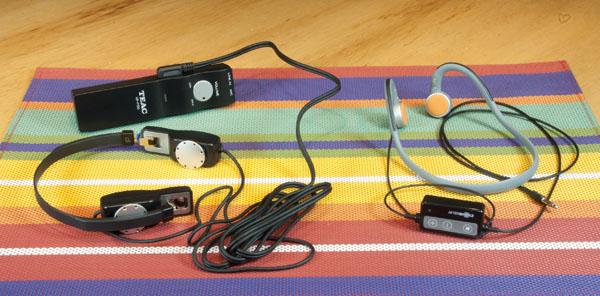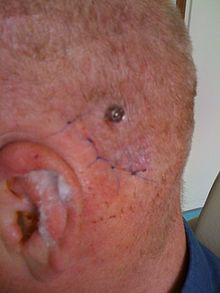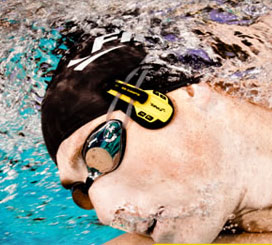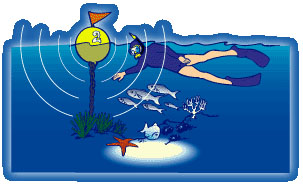| Columns Retired Columns & Blogs |
AfterShokz and TEAC Filltune HP-F100 Bone Conduction Headphones

This story originally appeared at InnerFidelity.com
Bone Conduction Headphones
My inbox was pummeled with press releases for the new Aftershokz Bone Conduction Headphone for weeks before CES, and these cans got a lot of attention there. Sure got my curiosity up, so I stopped by their booth for a listen, and walked away with a pair for review. But I don't know diddly about the technology, so I thought I should do a little homework before a serious evaluation. Turns out, there are quite a few very good applications for this type of transducer.
How it Works
It's pretty simple really: The small bones of your middle ear are anchored to the bones of your skull. When you put acoustic vibrations into your skull, they end up vibrating the little bones in your middle ear, and that gets transfered to the opening of your cochlea. Voila! You hear sound. Pretty straight forward.
Bone conduction headphones come in two flavors: mechanical and magnetostrictive transducers. Both are typically worn so that the transducer is pressing against the cheekbone about an inch in front of your ears. Mechanical transducers are much like dynamic speakers, and use a driver coil to magnetically move the part that touches your cheekbone to impart the vibration into the bones of your skull.
Magnitostriction is the impartation of kinetic energy into a non-ferrous material through magnetic force. Normally, we think of magnets only being able to move ferrous materials like steel, but there is another way. Many molecules have an electrical polarity. Water, for example, is an oxygen atom with two hydrogen atoms attached on either side, but because they aren't directly opposite each other, a water molecule has an electrical polarity. Because of this electrical polarity, when put in a magnetic field they will tend to align. In magnetostrictive headphones, the magnetic field is modulated with the audio signal, which torques all the molecules around, and makes a vibration in your skull that you hear.
(This is basically how MRI (Magnetis Resonance Imaging) works. Big magnets vibrate the soft tissue of the body, and because of the differing electrical polarity strength of the various soft tissue of the organs, an image contrast can be sensed. That's a brutally short explanation, but fundamentally accurate. Here's the Wiki.)
Medical Use Folks who have outer and middle ear problems can benefit strongly from bone conduction transducers as it bypasses the ear canal, ear drum, and to some extent, the normal workings of the middle ear. People with hearing loss associated with these parts of the ear can oft times regain some hearing with a bone conduction transducer. Here's a Wiki page on bone conduction implants for people with these types of problems. Folks who have outer and middle ear problems can benefit strongly from bone conduction transducers as it bypasses the ear canal, ear drum, and to some extent, the normal workings of the middle ear. People with hearing loss associated with these parts of the ear can oft times regain some hearing with a bone conduction transducer. Here's a Wiki page on bone conduction implants for people with these types of problems.
I like that.
|
Under Water I've not felt the need for music while swimming, but having been on the high school swim team I know how boring laps can be. Here's a an interesting product: SwimMP3 stores tracks in flash memory, and straps to your goggles to press on your cheek bones to deliver bone conducted tunes under water. I've not felt the need for music while swimming, but having been on the high school swim team I know how boring laps can be. Here's a an interesting product: SwimMP3 stores tracks in flash memory, and straps to your goggles to press on your cheek bones to deliver bone conducted tunes under water.
|
 Another very cool underwater application from Amphicom is a system of bouys, short range underwater FM transmitters, and bone conduction headphones to deliver narrated tours of reefs and underwater features. Another very cool underwater application from Amphicom is a system of bouys, short range underwater FM transmitters, and bone conduction headphones to deliver narrated tours of reefs and underwater features.
Ha! That would be fun.
|
Tactical Communications The most deadly serious application for bone conduction is in communication systems for military and law enforcement tactical teams. Here, team members have headsets that use bone conduction earpieces, and sometimes use vibration transducers pressed against the Adam's Apple. (Not shown in picture.) The most deadly serious application for bone conduction is in communication systems for military and law enforcement tactical teams. Here, team members have headsets that use bone conduction earpieces, and sometimes use vibration transducers pressed against the Adam's Apple. (Not shown in picture.)
The bone conduction earpieces (magnetostriction types) are pressed against the cheek bone, allowing the ear canal to be open to outside noise so team members can remain clearly aware of sounds in their environment. The magnetostrictive transducers make virtually no residual noise, and the neck microphones are able to pick up the merest whisper. Team members can communicate with each other in virtual silence allowing them to sneak around and communicate without offering any clues to their whereabouts. Mount the amazing night vision capabilities of today (I got to experience a state-of-the-art night vision scope not long ago and was stunned at how well it worked), and equip them with silenced weapons and ... well, I wouldn't want to confront these guys in the dark of night. 'Course, you'd never know they were there til it was too late. |
All very cool stuff, but how do they sound?
- Log in or register to post comments




































